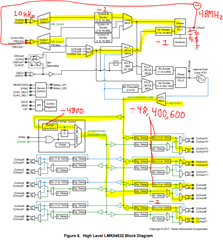Hi,
I have a jittery 10kHz reference clock that I want to use to generate/discipline a number of synchronous clocks in the tens of kilohertz range (e.g. 40 kHz, 40 kHz with a bit of phase, 80 kHz, 120 kHz).
I have evaluated the LMK05318 but, unfortunately, this only has one usable output in the kilohertz range. What device would you recommended?
Thanks,
Steve


